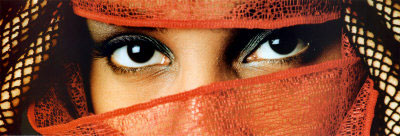Spellbound by Morocco
Morocco is a potent mix of the familiar and the foreign, and therein lies its appeal.

The country is at once Africa and the Riviera, snowcapped peaks and Saharan deserts, medieval cities and seaside resorts. It is baguettes and crisp white wines, couscous and sweet mint tea. It is the snake charmer, the water seller, the storyteller. It is shopping in serpentine bazaars of Fez and Marrakesh and paying with a credit card.
Yet for all its familiarity and amazing visitor comforts, Morocco is a profoundly foreign place. Women are often veiled; the hooded djellaba, or caftan, is ubiquitous on natives of both sexes; and the muezzin still calls the faithful to prayer from the minaret (although frequently via tape recording), for above all, this is an Islamic nation. Politically moderate, it is perhaps the most accessible Muslim country this side of Turkey. Aboard Royal Air Maroc from New York, the nonstop flight to Casablanca takes less than seven hours, and once in the country, clients will find fine restaurants, a distinctive and delicious cuisine, and accommodations a la 1001 Arabian Nights.
A 10-day trip to Morocco might, no, probably should, concentrate on exploring two wondrous places: Fez (three-and-a-half hours by car, 40 minutes by air from Casablanca); and Marrakesh (three hours by car from Casablanca or 45 minutes by air). The journey can end with a memorable drive from Marrakesh over the spectacular Tizi n’Test Pass to the unspoiled old market town of Taroudant, less than an hour from Agadir airport for a return flight to Casablanca.
Dreamy Marrakesh
Marrakesh is almost everyone’s favorite of Morocco’s four imperial cities or one-time capitals. It was founded in the 11th century by the Almoravid Sahara tribe, whose empire eventually stretched north to Spain and south to Senegal. Subsequent desert conquerors expanded the rust-red battlements and they now form an 11-mile wall around an oasis of elegant palaces, medieval mosques, majestic date-palms and flowering gardens. Separate arched gateways lead through the walls, and all avenues lead to the heart of the medina, the largest “old city” in the country, covering more than two sq. miles of Moorish courtyards and modern hovels, produce markets and craft souks spilling over with Berber carpets and caftans, leather goods, silver jewelry and copperware.
In the Marrakesh medina, 5 p.m. is curtain time in Djemma el-Fna for the Moroccan version of the greatest show on earth. In the huge square, acrobats twist and twirl, musicians serenade with half-tone tunes and snakes dance for their charming masters. In more serious corners, religious zealots preach, scribes handle correspondence and medicine men mix no-fail remedies to decrease pain and increase fertility. To position oneself above the fray, the best seat in the house is the second-floor terrace of the Cafe de France.
While there is no shortage of luxurious hotels in and around Marrakesh, most visitors will consider La Mamounia to still be the grande dame of destination properties. Surrounded by 17 acres of park-like grounds, the 230-room hotel stands tall in its Art Deco splendor, with grand halls and luxuriant gardens. The facilities are extensive and include several specialty restaurants, tennis/squash courts, an outdoor pool, a fitness center, and action-minded guests will find nearby options for golf and horseback riding. Rooms start at $360 dbl; double that figure for a 3-bedroom villa, but consider at least upgrading to a deluxe room with views of the Atlas Mountains.
Aman Resorts brought its brand of luxury to the city in early 2000 with the opening of Amanjena. Set in a palm and olive grove four miles from town and located within ocher walls, the property is a world unto itself. All 40 pavilions have a private patio and gazebo, a spacious bedroom, a living room and bathroom, a fireplace, DVD and CD players, and a private courtyard and fountain. The resort facilities include an immense pool, health center, tennis courts, two restaurants, and two nearby golf courses. Rates range from $850 to $2,600 for a 2-bedroom villa with private pool, garden and butler service.
In Marrakesh, alternate accommodations called riads are all the rage nowadays, offering calm hideaways within the medina. Europeans have been buying and restoring these traditionally 3-storied villas centered on tranquil colonnaded garden courtyards, and recouping their investments by opening them as guest houses. While there are now riads catering to every budget (and in the upper ranges, there are some wonderful ones), the most famous is La Maison Arabe, which started as a small restaurant with a big reputation attracting the likes of Winston Churchill and Queen Ingrid of Denmark during its 40-year run. Shuttered up in 1983, it reopened as a boutique hotel, a gem of a labor of love by owner Fabrizio Ruspoli. He created an elegant, 9-room and 8-suite retreat of remarkable Moroccan architecture and craftsmanship, complete with a traditional hammam—a kind of North Africa bathhouse—and attentive service. Its restaurant is, in fact, still one of the best Moroccan cuisine dining spots in town. Rooms range from $160 to $300 dbl.
Stunning Landscapes
Immediately south of Marrakesh, the Atlas Mountains fill the horizon with a jagged wall of blue, and the walled town of Taroudant is definitely worth a detour. During the spectacular 5-hour drive up and over the Tizi n’Test Pass to Taroudant, snowcapped Toubal, the highest of the Atlas Mountains (13,664 ft.), towers in the distance, and en route are ancient perched kasbahs, terraced fields clinging to the slopes, and the fertile farmlands of the Sous Valley.
Taroudant was briefly the capital of the Saadians before they established themselves at Marrakesh. Set amid orange groves and entirely ringed by stout crenelated walls, today’s Taroudant, a Berber market town, is a sort of small-scale, ancient town that Moroccan dream spots are made of: enchanting and relaxing. Beneath the ramparts, the handicraft souks are the place to buy native silver jewelry and finely worked textiles.
The height of lodging luxury, however, lies outside the walls at the enchanting Gazelle d’Or, once the home of a French baron. Its central pavilion gleams with patterned marble floors, its tented ceilings inlaid in mosaic. Grand stone cottages with woodburning fireplaces, marble baths and big terraces are set in rose-filled gardens, and guests play tennis, swim, ride horses in the desert and eat memorably on French and Moroccan cuisine in the excellent restaurant. Recreational enticements include a hammam and spa next to the pool—with the Atlas Mountains on the horizon. Per person rates, on half-board basis, start at $270.
Fabulous Fez
Other than the breathtaking landscapes and kasbahs of the deep south, one of the top picks in Morocco is Fez. With a history harking back 1,000 years—making it the oldest of Morocco’s four imperial cities—Fez is the heart and soul of Morocco and its intellectual, religious and artistic capital. Among dozens of fascinating corners, the Kairouan mosque, a masterpiece of Andalusian architecture, is billed as the largest in Africa, and the wondrous medieval medina is the largest in the country.
The legendary Palais Jamais, a former vizier palace with spellbinding views of the medina’s sprawling rooftops, domes and minarets, is another reason to come to Fez. Built as a pleasure palace at the end of the 19th century and now a member of the Sofitel Hotels & Resorts group, the original structure houses one restaurant and its most spectacular suites. Overall, the expanded property has 123 rooms and 14 suites, as well as a pool, three restaurants, a sauna and tennis courts. Double rooms with breakfast range from $165 to $725.
A totally different lodging experience is offered at La Maison Bleue, a gem of a luxury guest house right on the main Dar Batha Museum square and built as a family palace in 1915. Three Moroccan salons surround the courtyard, while five deluxe rooms—with ensuite bathrooms, TV, Internet access, minibar and safe—occupy the first and second floors. Maison Bleue’s restaurant rates as one of the country’s best, and the views from two rooftop terraces among the medina’s finest. Double room rates start at $220.
Spa-Bound
The Moroccans didn’t invent the hammam, they borrowed the bath tradition from the Turks, and added the essential accessories of a kiss (scrubbing mitt) and sabon bildi (black olive-oil soap). While the hammam experience is an important aspect of local life, this bathing ritual is a central attraction—complete with marble settings, and perfumed with sandalwood and orange blossoms—at the trio of spas that are members of the Relais & Chateaux hotel group in Morocco.
They are also part of the hotel group’s larger program called Spa & Beaute, which offers 2- and 6-night packages at 44 worldwide properties. The shorter program starts at approximately $570 for two people, and includes a deluxe room, breakfast, one massage and one beauty treatment pp. The longer spa stay features accommodations with breakfast and dinner, three massages and three beauty treatments pp, with costs starting at $2,240 for two.
In Morocco, the newest member is the L’Heure Bleue Palais in coastal Essaouira, occupying a former palace that has been turned into a family residence. The rooftop pool has a stunning view of the Atlantic beyond the ramparts; facilities include a spa, hammam, and mud bath.
In La Palmeraie on the fringes of Marrakesh, the Ksar Char-Bagh spa experience includes Oriental relaxation treatments, steam baths, kiss glove body scrubs, black soap and herbal treatments; there is also an outdoor pool and fitness facilities.
In the Skoura oasis at the gateway to the desert near Ouarzazate, 19th century, adobe walls enclose the Dar Ahlam, with its magnificent suites and villas. While guests can ride a camel or motorbike, spa lovers will find a pool, hammam and jacuzzis on premises. Call (800) 735-2478 or visit www.relaischateaux.com.
Trip Write Ups
- Amalfi and Tuscany
- An American Safari
- Argentina: Latin Lovers and Tango!
- Costa Rica
- Cuba
- Dubai
- Egypt
- Graz - Austria
- Historic Quebec
- Holland at Tulip Time
- Japan
- Lake Como
- Lisbon
- Spellbound by Morocco
- Follow me North to Alaska
- A Passage to India
- Prague and Berlin
- Seabourn Odyssey ... Luxury Redefined
- South Africa
- Tahiti
- Vietnam, Laos & Bankok
- Nicaragua

